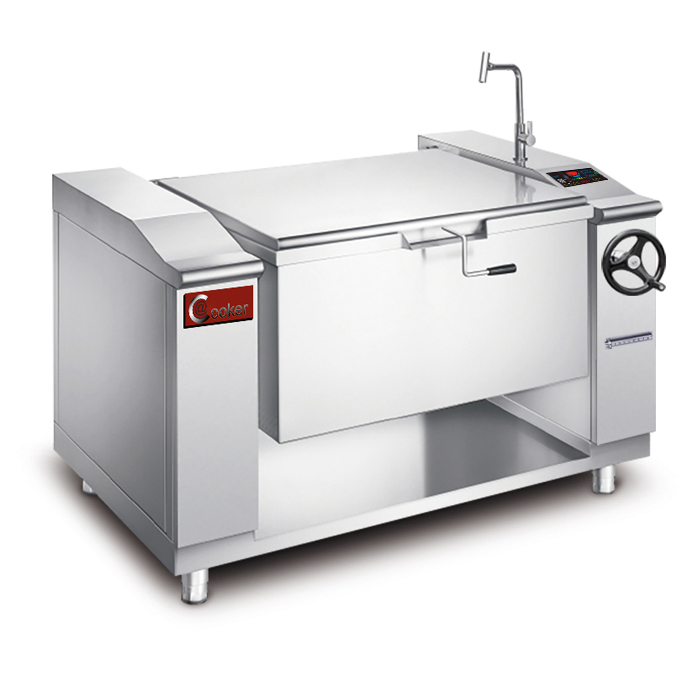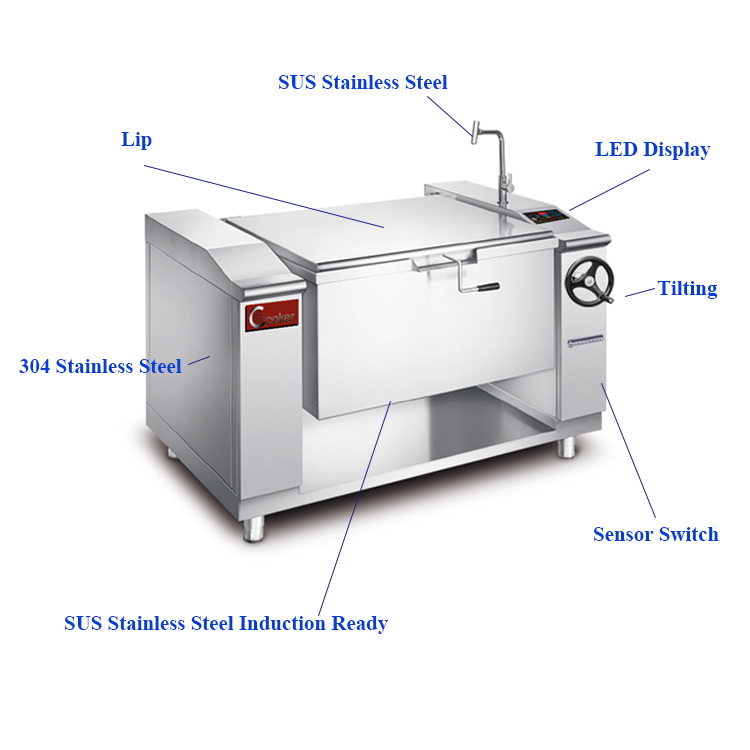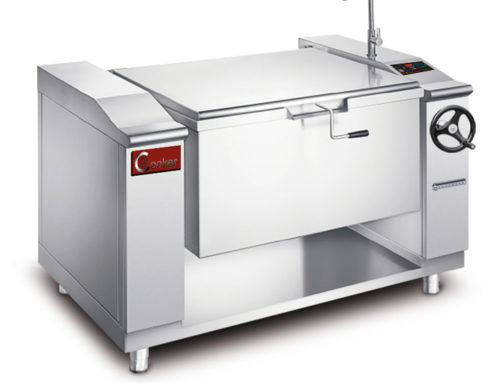What Bratt Pan Capacity (Liters/Quarts) Do You Need for Your Operation’s Volume?
Choosing the right capacity for your bratt pan cooking equipment is critical to avoiding bottlenecks during peak service or wasting energy on underused large units. Capacity is measured in liters (standard for commercial equipment) or quarts (1 liter ≈ 1.0567 quarts), and the right size depends on your operation’s volume—from small cafes to stadiums. At AT Cooker, a leading supplier of bratt pan cooking equipment, we offer electric tilting bratt pans in 80L to 300L capacities (≈84.5 to 317 quarts), engineered for efficiency (90-95%), durability (304# stainless steel), and safety (anti-overheating warnings). In this guide, we’ll break down capacity recommendations by operation size, link them to real-world cooking needs, and show how AT Cooker’s models fit your volume requirements.
AT Cooker Bratt Pan Capacities & Ideal Operation Volumes
| Model | Capacity (Liters/Quarts) | Ideal Operation Type | Daily Volume Handled | Key Features for Volume Needs |
|---|---|---|---|---|
| ATT-ABT-BP (80L) | 80L / 84.5Q | Small cafes, 50-seat restaurants | 20-40 lbs of food (e.g., 25 lbs of braised beef) | 8 power levels, 15KW power, 10-hr countdown |
| ATT-ABT-BP (120L) | 120L / 126.8Q | Medium restaurants, small hotels | 40-60 lbs of food (e.g., 50 lbs of fried chicken) | Auto water valves, anti-voltage warning, 304# steel |
| ATT-ABT-BP (150L) | 150L / 158.5Q | Large restaurants, schools | 60-80 lbs of food (e.g., 70 lbs of vegetable soup) | 5-year warranty, auto fault detection, 20-30KW power |
| ATT-ABT-BP (200L) | 200L / 211.3Q | Hotels, catering companies | 80-100 lbs of food (e.g., 90 lbs of roasted pork) | Heavy-duty build, real-time power display |
| ATT-ABT-BP (300L) | 300L / 317Q | Stadiums, military bases | 100+ lbs of food (e.g., 120 lbs of chili) | 30KW power, extra-large tank, 95% efficiency |
Small-to-Medium Operations: 40-60 Liters (42-63 Quarts)
Small-to-medium operations—including 50-seat restaurants, cafes, and small delis—typically serve 50-150 customers daily, with average batch sizes of 10-30 pounds (e.g., 15 lbs of sautéed vegetables or 20 lbs of braised pork). A bratt pan capacity of 40-60 liters (≈42-63 quarts) is sufficient here, as it balances batch size with energy efficiency—you won’t waste power heating a large empty tank, and you can cook enough food to cover peak rushes (e.g., lunch service for 50 guests).
- Flexibility for growth: Handles 20-40 lbs of food per batch—enough to scale from 50 to 75 customers without upgrading.
- Energy efficiency: 90-95% efficiency means it uses no more power than a 60L model when cooking smaller batches.
- Versatility for bratt pan uses: Perfect for sautéing, braising, and boiling—critical for cafes with diverse menus (e.g., breakfast hash, lunch soups, dinner braises).
For a cafe serving 100 customers daily, this model eliminates the need to cook multiple small batches, saving 1-2 hours of staff time.
Pro Tip: Avoid undersized 30L models for small operations. They require cooking 2-3 batches to meet peak demand, increasing labor and energy costs. AT Cooker’s 80L model is a cost-effective middle ground.
Large-Scale Operations: 80-100 Liters (85-105 Quarts) & More
Large-scale operations—such as 150+ seat restaurants, hotels, schools, and hospitals—serve 200+ customers daily, with batch sizes of 40-80 pounds (e.g., 60 lbs of pasta sauce or 70 lbs of roasted vegetables). These operations need bratt pans of 80-100 liters (≈85-105 quarts) or larger to cook enough food in one batch, reducing labor and ensuring consistent quality across servings.
AT Cooker’s 120L & 150L Models: Built for Large Volumes
Our 120L (≈126.8 quarts) and 150L (≈158.5 quarts) bratt pan cooking equipment are designed for large operations. Key features that support high volume:
- Powerful heating: 20-30KW power reaches 356°F (180°C) in 10 minutes, so you can cook back-to-back batches during peak service (e.g., dinner rush for 200 guests).
- Auto water valves: Automatically refill the tank between batches—no staff time wasted on manual filling, critical for schools serving 500+ students at lunch.
- Durability: 304# stainless steel body withstands 8+ hours of daily use, a must for hotels with 24/7 kitchen operations.
A hotel using our 150L model can cook 70 lbs of vegetable soup in one batch—enough to serve 300 guests—cutting cooking time by 50% compared to a 80L model.
Extra-Large Operations: 200L+ (211+ Quarts)
Extra-large operations—stadiums, military bases, large catering companies, and convention centers—serve 500+ customers daily, with batch sizes of 100+ pounds (e.g., 120 lbs of chili or 150 lbs of fried onions). These operations need bratt pans of 200 liters (≈211 quarts) or more to handle massive volumes without constant reloading.
- 300L Capacity: Cooks up to 100+ pounds of food per batch—enough to serve 500+ guests (e.g., 120 lbs of beef stew).
- Heavy-duty tilting: Hydraulic assist makes pouring large batches easy, reducing staff strain when serving 10+ buffet lines.
- 10-hour countdown: Ideal for long cooking tasks (e.g., slow-braising 150 lbs of pork for a stadium concert), with automatic temperature maintenance to ensure food quality.
A military base using our 300L model can prepare 150 lbs of vegetable stir-fry in one batch—feeding 600 soldiers—saving 4+ hours of cooking time compared to smaller pans.
Key Factors to Match Capacity to Your Volume
Choosing capacity isn’t just about operation size—consider these factors to avoid over- or under-investing in bratt pan cooking equipment:
- Average batch size: If you regularly cook 30 lbs of food (e.g., 30 lbs of mashed potatoes), a 60-80L pan works. If you cook 80 lbs, jump to 120-150L.
- Peak service volume: A restaurant with 50 seats may need an 80L pan if it serves 30 guests at once (lunch rush), even if daily volume is small.
- Menu complexity: Operations with diverse bratt pan uses (sautéing, braising, boiling) benefit from slightly larger pans—they can handle different batch sizes for different dishes.
- Future growth: Choose a pan 20-30% larger than your current needs. A cafe planning to add 20 seats should pick an 80L pan instead of 60L.
- Energy efficiency: Larger pans use more energy—AT Cooker’s 90-95% efficiency minimizes this, but avoid 200L+ pans if you only cook 40 lbs of food daily.
Expert Tip: When shopping for bratt pan for sale, ask suppliers to calculate capacity based on your menu. AT Cooker’s team uses your daily dish volume (e.g., 50 lbs of soup, 30 lbs of braised meat) to recommend the exact model—no guesswork.
Specialty Operations: Under 30 Liters (32 Quarts)
Specialty operations—food trucks, small bakeries, or restaurants with limited menu items—may only need bratt pans under 30 liters (≈32 quarts). These pans are designed for small-batch, niche uses: e.g., a food truck making 10 lbs of caramelized onions per day or a bakery preparing 8 lbs of fruit compote.
Conclusion: Find Your Perfect Bratt Pan Capacity with AT Cooker
Your bratt pan cooking equipment capacity should align with your daily volume, batch size, and growth plans: small operations (40-60L), large operations (80-100L+), and extra-large settings (200L+). AT Cooker’s electric bratt pans—from 80L to 300L—are engineered to match these needs, with features like efficiency, durability, and safety that make high-volume cooking easier. Whether you’re a cafe or a stadium, we have a pan that fits your volume without wasting energy or labor.
Ready to choose the right capacity? Contact AT Cooker today to share your daily food volume and menu—our team will recommend a bratt pan cooking equipment model that saves you time and money. With 20 years of experience, we’re your trusted partner for commercial kitchen efficiency.


